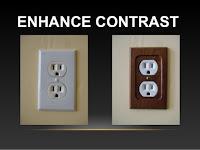Age-related macular degeneration (ARMD) is a disease that affects the macula, the center of the retina, and is the leading cause of vision loss in people over 60 years old (Lewis, 2003). The macula gradually deteriorates causing the central vision to be lost but the peripheral vision still intact.
 |
| Image Retrieved here |
According to Lewis, here are 3 interventions to take place in a home environment:
1. Lighting is crucial to improve visual functioning for people with Macular Degeneration. Whether it’s brighter overhead lighting in a kitchen to perform cooking, task lighting for reading/writing, or increased lighting on stairs to help prevent falls, extra lighting is essential. LED lights are recommended for people with macular degeneration
 |
| Image retrieved from here |
 |
| Link to Floor Lamp Magnifier |
A couple more facts to know when designing for someone with macular degeneration:
- LED lights are recommended over incandescent light bulbs: Since sunlight is a factor in macular degeneration, lamps that mimic sunlight can have a negative effect on the eye. A significant factor is the spectrum – the different colors that make up the light. The colors of the visible spectrum are the colors of the rainbow: red, orange, yellow, green, blue, indigo, and violet. The low energy red through the moderate energy violet are not harmful and are necessary for vision. However, high energy ultra-violet light, mostly UV-B, is responsible for damage to materials, skin, and eyes. Eliminating UV-B from man made light sources is desirable and very prudent for lighting used by individuals over 40. With new technology such as LED (Light Emitting Diode) light sources, it is possible to make a lamp that is tailored to people with macular degeneration. LEDs designed for reading lights have no UV and extremely low IR (Infra Red) emissions.
- Use a yellow color background to increase visual perception of objects. Yellow backgrounds seem to be preferred by most of healthy and AMD eyes. This preference may be modulated by factors such as the yellow-blue vision processing channel and/or luminosity differences produced by selectively transmitted light.
